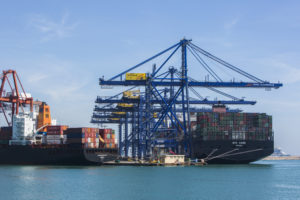
The Covid-19 crisis continues to condition commercial activity which is reflected in an 8.4% increase in freight rates with the Far East and a 1.56% decrease in the Western Mediterranean
The idle fleet in June reaches 453 units and is reduced compared to May. The trend for the coming months is the reduction of the inactive fleet
València, June 3rd, 2020.- The Valencia Containerised Freight Index (VCFI) experienced a slight increase of 1.62% in June compared to the previous month, reaching 1,266.07 points, in a situation that continues to be conditioned by the crisis generated by the Covid-19 health emergency, which is reflected in the forecasts of the contraction of the world economy according to the main international organisations. Thus, increase the 8.4% in freight rates with the Far East, while in the Western Mediterranean they fell by 1.56% in June, which shows the variation in maritime transport prices. The idle fleet represents 9.9% of the total active fleet, reaching 453 units, a lower figure than that registered in May.
The crisis caused by the Covid-19 health emergency continues to affect economic activity and condition international trade flows. Recent weeks have seen an economic reactivation in many parts of the world and that is reflected in trade traffic. In this context, the Valencia Containerised Freight Index (VCFI) for June shows a slight rebound, with an increase of 1.62% on the previous month, to 1,266.07 points. The figure for accumulated growth since the start of the VCFI series in January 2018 stands at 26.61%.
In terms of the indicators with an impact on this trend, it must first be pointed out that since early May the price of bunkering has been trending upwards to date, albeit at levels still below those of previous months. Oil prices have performed similarly. European Brent bottomed out in April at 18.38 dollars per barrel, the lowest price seen this year, before progressively rebounding to reach an average of 40.20 dollars for the month of June.
In this regard, one of the main conditioning factors for the performance of freights is the functioning of the international economy scenario, which drives the supply and demand conditions of capacity on the maritime transport market. According to the latest data published by the International Monetary Fund, in its June 2020 World Economic Outlook, the world economy is expected to contract by 4.9% in 2020, with international trade following the same trend but with a more intense contraction, of 11.9% (including tourism activity).
Shipping companies have adapted to this global market scenario of reduction in demand. They have, among other measures, reduced capacity on some of the world’s major container shipping routes, such as those between Europe and the Far East. This is reflected in the idle fleet figures from early June (8 June) which reached 521 units and 2.61 million TEUs, representing 11.2% of the total active fleet (Alphaliner). Of the 521 inactive vessels, just 11.7% are idle for the installation of scrubbers (filters that purify fumes from vessels to prevent particle and sulphur emissions), meaning the rest are idle due to the current market situation. Nevertheless, the latest data to be published (22 June) show a reduction in idle fleet levels, representing 9.9% of the total active fleet, or 453 units, an improvement on the figures from earlier the same month. While this remains a high percentage for idle fleet, it is a reduction on the idle fleet levels of late May, which reached 11.6% of the total active fleet. According to Alphaliner, this slight decrease is not expected to be an isolated occurrence and the coming months will see a progressive reduction in the idle fleet percentage as shipping companies reincorporate some lines that were temporarily suspended due to the exceptional situation caused by Covid-19.
Performance by areas
Despite the fact that the VCFI general index shows moderate growth in freight levels, it is true that when analysed by areas, most are shrinking and there are only three areas where maritime transport prices are on the increase. These areas where export freights increased are the Middle East (+13.08%), the Far East (+8.40%) and the Eastern Mediterranean (+0.20%). In terms of other areas, the most acute decrease seen is in Atlantic Latin America (-14.17%), followed by Africa East Coast and the United States while the other areas have seen minor decreases (of less than 1.5%). While low bunkering prices could be a key common factor in all areas, the peculiarities and trends in freights in each area reveal divergences in terms of performance in each of them. In the case of the United States and Canada, from January to April 2020, frights grew at levels in excess of 1.5%.
Freights with the Western Mediterranean fell by 1.56% in June, with the value of the index standing at 1,049.28, a figure that failed to confirm the trend for May, when there was a slight increase. On balance, the increases are greater than previous decreases, meaning that the index has remained above 1,000 at all times, which is uncommon for this sub-index. With respect to the Far East, after a reduction in May, freight rates grew again in June by 8.40%. Thus, the VCFI regional sub-index for the Far East stands at 1,871.90 points, its historic maximum since the start of the series in January 2018.
If you want more information, click here

